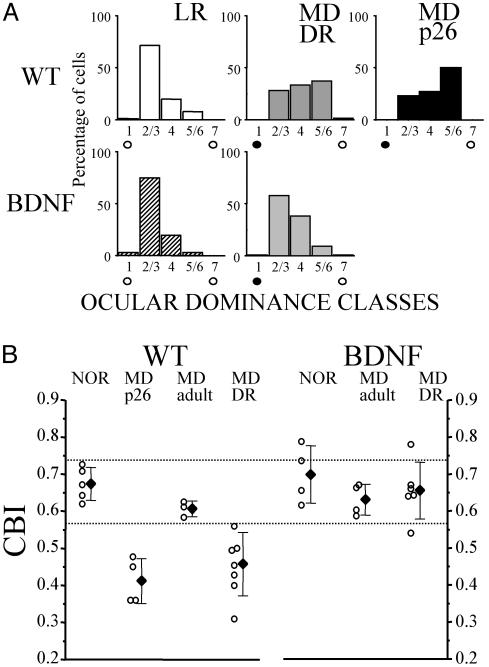Fig. 4.
Effects of DR on OD plasticity of wild-type (WT) and transgenic mice. DR prolongs the critical period of MD in wild-type but not in BDNF mice. (A) ODD was measured by dividing single units into five classes following the classification of Hubel and Wiesel (28). (Upper) In adult (P40) LRWT mice, ODD was strongly biased toward the contralateral eye (91 cells, five mice). MD during the peak of critical period (at P26, MDp26, 74 cells, four mice) but not in adult (88 cells, three mice) shifted ODD toward the open/ipsilateral eye. In DRWT mice, MD at adult age (P40) still shifted ODD toward the open/ipsilateral eye (MDDRWT, 153 cells, seven mice), indicating a delayed critical period by DR. (Lower) In adult (P40) LRBDNF mice, as in LRWT, ODD is also strongly biased toward the contralateral eye (67 cells, five mice). MD at adult age did not induce OD plasticity in LRBDNF mice (77 cells, four mice). In DRBDNF mice, however, MD at adult age (P40) still did not induce OD shift toward the open/ipsilateral eye (MDDRBDNF, 153 cells, seven mice), indicating normal closure of the critical period. (B) Results in A are quantified by calculating the CBI (see Materials and Methods). In LRWT mice, binocular visual cortex is dominated by contralateral eye (meanCBI = 0.67, SD = 0.04); MD at P26 induced OD shift (meanCBI = 0.41, SD = 0.06); MD at adult age had no effect on ODD (meanCBI = 0.61, SD = 0.03). In DRWT, MD even at adult age induced OD shift (meanCBI = 0.45, SD = 0.08). In LRBDNF mice, contralateral eye input is also dominant (meanCBI = 0.67, SD = 0.04); MD at adult age had no effect on ODD (meanCBI = 0.63, SD = 0.04). In DRBDNF mice, however, MD at adult age remains ineffective in inducing OD shift (meanCBI = 0.66, SD = 0.02).

